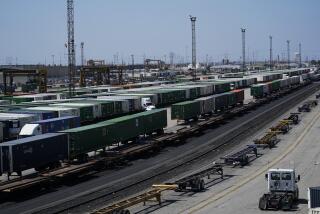Derailment Was Seen as Best of Poor Options
- Share via
Dispatchers derailed a runaway freight train in Commerce last year rather than risk hitting a commuter liner or a train carrying liquefied gas and chlorine, according to a final report on the accident released Friday by the National Transportation Safety Board.
Providing details of the rush of decisions leading to the June 20 derailment, the report blames Union Pacific railroad and a pair of its work crews for the accident.
Union Pacific did not do enough to enforce its own safety rules, and the railroad’s dispatchers did not know enough about the route its trains passed through, investigators found. Most important, brakes were not properly applied as the train sat in a Montclair rail yard.
That failure allowed the 31-car train to roll from the yard with nobody controlling it. It reached nearly 100 mph on a 28-mile journey that ended in a maneuver that caused it to derail. Cars tumbled into homes, and lumber spilled into streets and yards. Three homes were destroyed and more than $2 million in damage was incurred.
If the braking had been proper, the cars “would not have rolled away and this event would not have happened,” said lead NTSB investigator Bob Chipkevich.
Early on a Friday, the train traveled from a depot in East Los Angeles to the Montclair yard, hauling lumber and paper products. According to the report, workers at the yard told the train crew not to apply hand brakes, because some of the cars were going to be moved by a locomotive to another part of the yard.
Without hand brakes, a system of backup air brakes kept the train in place. But the report said that after the crew left the train, two yard workers began manually releasing the air brakes.
Usually, a locomotive would be attached to the cars before the air brakes were released, said Roland Kleinsorge, a Brotherhood of Locomotive Engineers representative familiar with the case. The locomotive would control and steady the brakeless rail cars, he said.
In this case, the train began rolling west. Thinking they could jump aboard and set the hand brakes, the two yard workers ran after the train but couldn’t catch it, the report said.
At 11:34 a.m., the train slipped out of the yard. By then, Union Pacific dispatchers in San Bernardino were aware of the runaway train.
The report said dispatchers didn’t know that the track from Montclair running toward L.A. slopes downhill almost continuously.
“Personnel in the dispatcher’s office ... also did not know the number of cars that were running away.... They expected the cars to slowly come to a stop.”
An engineer at the yard radioed the dispatch center, asking if he could use a locomotive to try to track down the runaway train, attach to it and stop it. The chief dispatcher turned the request down, fearing a collision. The dispatcher told investigators he thought the train would stop and possibly even roll back toward the Montclair yard.
Instead, the train was picking up speed. As it passed through Pomona, dispatchers had few options. They considered trying to slow or control the train by switching it to a different track. But one track was occupied by a Metrolink train. Another led to a fuel storage facility. Switching to a third track “would have caused a head-on collision with a 93-car train [carrying] hazardous materials, including several cars of liquefied petroleum gas and chlorine residue,” the NTSB concluded.
At 11:47 a.m., the chief Union Pacific dispatcher decided that the only option was to direct the train to a stretch of siding in Commerce known as Track 4, using radio signals to control the track’s direction.
“We’re going to go into Track 4; there’s no place else to go,” the dispatcher told subordinates. At 11:54 a.m., a device on the tracks informed dispatchers the train was going at least 86 mph.
The report concludes that Union Pacific dispatchers knew the train would probably derail at Track 4, since the speed limit there is 15 mph. But they hoped it would do so without spilling cars and cargo onto homes.
At 11:58 a.m., as it switched to Track 4, the train derailed.
The report says UP has taken steps since to prevent trains from getting loose, including revamping its braking procedures and auditing its rail yards. It has also installed switches that can derail runaway rail cars within the Montclair and other yards, and has updated its maps.
More to Read
Sign up for Essential California
The most important California stories and recommendations in your inbox every morning.
You may occasionally receive promotional content from the Los Angeles Times.














